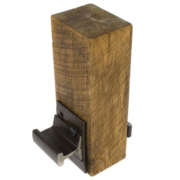Biomimicry & Las Chicas de Matematicas
by Amy Kirtland
This past summer I was a guest speaker at Las Chicas de Matematicas, a week long in-residence math camp for high school girls, held at the University of Northern Colorado. The goal of the camp is to introduce college level math to high school students while also exposing them to campus life and working professionals who use math in their careers. The young women from previous years’ camps had requested that an architect speak at this year’s camp, and that’s where I enter the story.
I was asked to speak about my career as an architect, how I use math in my daily work-life, and how I balance my professional and personal life. Considering that over 10 years of my professional career have been spent at Barrett Studio, I decided to use the studio’s design work as a focus for my presentation. At Barrett Studio we “listen to the land,” using climatic and site factors as informers of design. This can include data gathering and analysis of weather patterns, calculating sun angles, GIS mapping, and good old time spent on site as an observer. The data we collect and the experiences we have inform and directly influence the design of the structure, sometimes quite figuratively.
As I began to assemble the slides and piece my presentation together, it evolved from a discussion of site analysis into a discussion of nature’s beauty and biomimicry – taking inspiration from or emulating nature and its processes, through examination, to solve human problems – as design formulator. Biomimicry in architecture can be a formal or morphic study, or the investigation of a natural system can become more complex and include mathematics or processes. Below are a few images of biomimicry within our work and other architects’ work.

The nautilus shell and its Golden Mean spiral became the organizing geometry for Barrett Studio’s proposed design of the Greenwood Wildlife Rehabilitation Center.

The Catenary curve (left) graphs the hyperbolic cosine function. It occurs in nature frequently and is the curve that is naturally formed by a hanging chain or cable supported only at its ends. Gaudi flipped this curve upside down and used it as an arch in the design of La Sagrada Familia (center) and many of his other buildings. The Catenary curve has also been used in numerous bridge designs and notably the St. Louis Arch (right).

The dynamic form of this Frank Gehry building in Prague was shaped by images of Fred Astaire and Ginger Rogers dancing.

Barrett Studio examined the structure of the cactus and its thick stem that stores water. This was the formative idea behind the Casa Viento wind surfing retreat in Venezuela – the central core of the building became a place for plumbing and bathroom areas while the living spaces acted as “spines” that catch breezes from multiple sides.
The Milwaukee Art Museum mimics a bird in flight as its kinetic brise-soleil unfurls day and night.
During and after my presentation, the girls were very engaged and asking lots of questions…I had piqued their interests! They were particularly intrigued by the Casa Viento windsurfing retreat and how we used and abstracted not only the physical form of the cactus, but also its internal mechanisms. The exotic location of the retreat was also a point of interest for the students. It is always refreshing to see raised hands and wide open eyes when you finish a presentation. I wanted to show these students that architecture can combine art, science, and math to create unique spaces that we inhabit and experience life within. I’ve found that thoughtful design can be aesthetically pleasing, functionally adept, and intellectually stimulating. Perhaps the architecture I presented germinated the seed in the next budding architect!

















Leave a Reply
Want to join the discussion?Feel free to contribute!